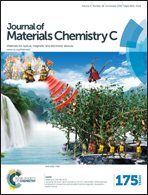Metallic back-contact interface design in photoelectrochemical devices†
Abstract
Metal/metal-oxide interfaces appear in a wide variety of electronic applications. One such example is oxide based photoelectrochemical (PEC) cells in which the oxide constitutes the cell's active material, and is in contact with a metal back-contact that assists in charge transport. The proper choice of contact can have a substantial impact on the cell's performance. Hence, understanding the correlation between contact composition and performance is of crucial importance. For these reasons, in this paper we perform DFT+U calculations on several metal/oxide interfaces. Specifically, we examine the Mt/Fe2O3 interfaces for: Mt = Ag, Al, Au, Ir, Pd, and Pt, and the Pt/M2O3 interfaces for: M = Al, Cr, and Fe. The above interfaces have recently attracted much attention in PEC water splitting based on α-Fe2O3. We find a trend which describes the adhesion energy as a function of the interface bond distance between the metal and the oxide. This can be used to predict adhesion energies without performing a very expensive interface calculation, or experimental measurements. Furthermore, we find a correlation between the energy of adhesion and the surface charge in the first bonded layer of the FCC metal, such that a larger adhesion is associated with an increase in the bond ionicity. Finally, in each interface we find that the effective mass is reduced in the oxide due to metallic deposition and there are metal induced gap states (MIGS). These can help identify metal/oxide junctions that provide good contacts for charge transport. We predict that Ir metal should provide an ideal contact for Fe2O3 based PEC cells.



 Please wait while we load your content...
Please wait while we load your content...